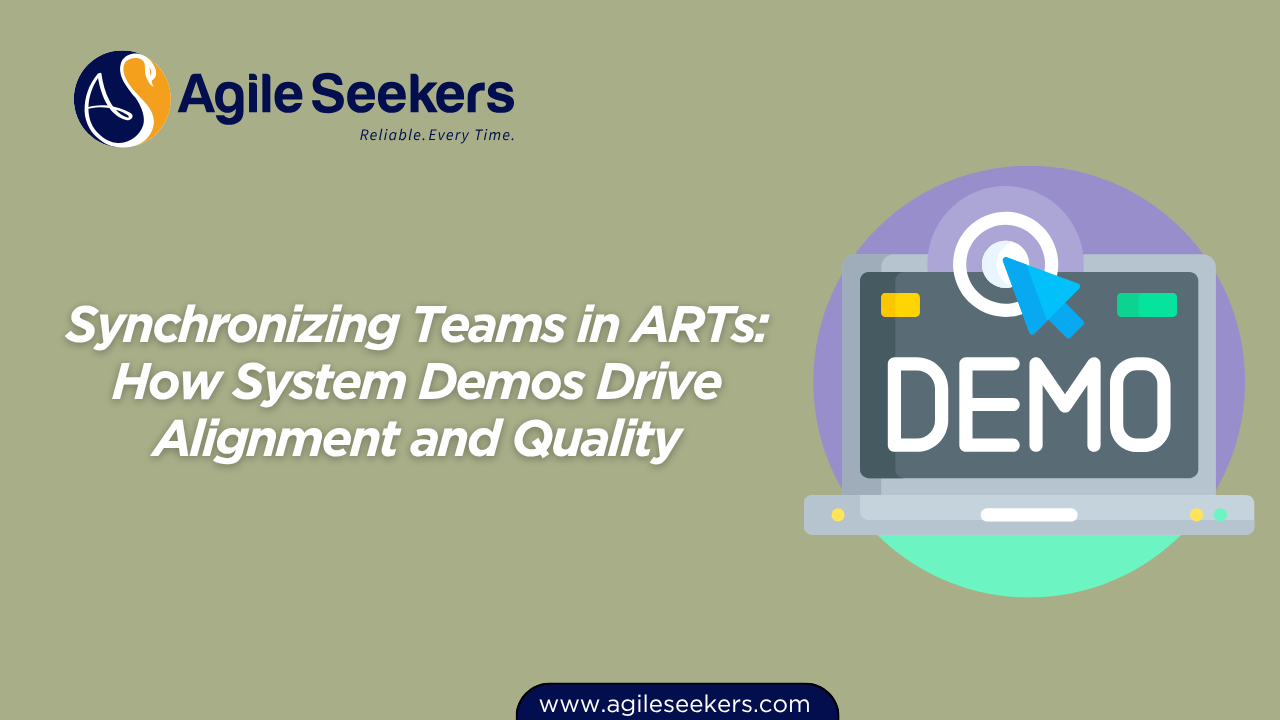Synchronizing Teams in ARTs: How System Demos Drive Alignment and Quality

In SAFe® (Scaled Agile Framework), alignment across multiple Agile teams is not a coincidence—it’s engineered. One of the key mechanisms that makes this possible is the System Demo. While often seen as just another ceremony, the System Demo plays a central role in reinforcing alignment, ensuring quality, and maintaining a continuous feedback loop across the Agile Release Train (ART).
This post explores how System Demos function as a powerful synchronization tool for ARTs and how they help deliver real value with built-in quality.
What is a System Demo?
A System Demo is a live, end-to-end demonstration of the integrated work delivered by all teams in the ART during a Program Increment (PI) iteration. It happens every iteration, not just at the end of the PI. Unlike individual team demos, which showcase a single team’s output, System Demos present the full system behavior—tested, integrated, and valuable to the customer.
Why System Demos Matter for ART Synchronization
1. Common Visibility Across Teams
System Demos offer a shared view of what has been built so far. When teams work in isolation, it's easy for misalignment to creep in. System Demos bridge this gap by providing a consolidated picture that helps all stakeholders—Scrum Masters, Product Owners, Release Train Engineers, Architects, and Business Owners—see the current state of the product.
Integrated visibility aligns teams around actual progress rather than assumptions.
This approach ties closely with the collaborative mindset taught in Leading SAFe certification training, which stresses the importance of transparency and alignment in complex systems.
2. Immediate and Constructive Feedback Loop
Each System Demo includes feedback from internal stakeholders and customers (if possible). Instead of waiting until the end of the PI, feedback is gathered incrementally, enabling mid-course corrections. This not only reduces risk but also increases the likelihood of delivering what the customer actually wants.
Feedback at every demo iteration turns course correction into a proactive process, not a rework cycle.
This directly supports the role of SAFe Product Owner/Product Manager (POPM), who is responsible for managing customer expectations and ensuring that features align with business objectives.
3. Driving Built-In Quality
System Demos expose integration issues early. If there’s a misalignment between components, a System Demo will make it obvious. This forces teams to prioritize integration and testing throughout the PI, not just at the end. It enforces the SAFe principle of Build Quality In.
Quality is not tested in at the end—it’s reviewed in real-time through working software.
Teams that internalize this habit—especially those with SAFe Scrum Masters trained through SAFe Scrum Master certification—are more likely to produce sustainable, scalable solutions.
4. Creates Alignment Across Roles and Hierarchies
From Business Owners to Team Members, the System Demo becomes a focal point where alignment is visible, measurable, and discussable. Dependencies between teams, unclear scope, or design decisions are surfaced transparently. Everyone walks away aligned on next steps.
Alignment isn’t declared in meetings—it’s demonstrated through working, integrated systems.
Release Train Engineers trained in SAFe Release Train Engineer certification facilitate these demos to ensure smooth collaboration and keep the ART on track.
Conducting an Effective System Demo
✅ Preparation
-
Ensure all teams integrate their code regularly
-
Automate build and testing where possible
-
Confirm stories are complete (Definition of Done)
✅ Demo Structure
-
Demonstrate capabilities, not just features
-
Use real data and environments
-
Keep a consistent format across iterations
✅ Facilitate Feedback
-
Invite Business Owners, SMEs, and even customers
-
Record insights and actions
-
Clarify priorities based on feedback
The System Demo becomes a collaborative checkpoint, not just a status update. That’s a mindset shift supported by the SAFe Advanced Scrum Master certification, which equips Scrum Masters to navigate cross-team complexities in large-scale delivery.
How System Demos Support the PI Objectives
Each PI begins with a planning session where teams commit to objectives. The System Demo allows stakeholders to evaluate progress against those objectives throughout the PI. This visibility helps:
-
Adjust plans based on evolving understanding
-
Shift priorities before rework becomes expensive
-
Strengthen trust through transparency
These demos don’t just validate what was built—they validate whether it’s the right thing, built the right way.
Linking System Demos to SAFe's Core Values
| SAFe Core Value | System Demo Contribution |
|---|---|
| Alignment | Keeps everyone in sync through shared product understanding |
| Built-in Quality | Surfaces integration and performance issues early |
| Transparency | Shows real progress, not slideware |
| Program Execution | Drives frequent inspect-and-adapt cycles |
This aligns directly with how the Leading SAFe Agilist role anchors Lean-Agile leadership to execution effectiveness.
External Reference on Demo Best Practices
The Scaled Agile Framework article on System Demos explains that the demo is not just an event—it’s a mindset. It must be consistent, customer-focused, and outcome-driven.
For organizations looking to scale Agile across teams and functions, treating the System Demo as a critical, non-negotiable practice is a game-changer.
Final Thoughts
System Demos are more than checkpoints—they’re the heartbeat of ART synchronization. By regularly showcasing integrated progress and enabling timely feedback, they create clarity, alignment, and quality across large teams.
The ART becomes more than a group of Agile teams—it becomes a unified delivery engine.
To effectively support and lead these practices in your organization, consider training in roles such as SAFe Product Owner/Product Manager (POPM), SAFe Scrum Master, or Release Train Engineer through AgileSeekers.
These certifications help professionals not just participate in, but lead, high-performing ARTs driven by transparency, alignment, and relentless improvement.
Also read - How to Structure a High-Performing Agile Release Train




















